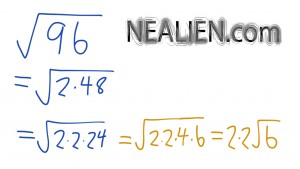Like Terry Moore said, it actually is pretty easy to work with in the original form,
√96.
Sometimes it is better to ‘simplify’ by getting a coefficient multiplied by a smaller number within the radical. Other times, you’re really not simplifying, but making it more complicated. This is probably one of those times where leaving it as √96 is better.
If you had something like √196, you would want to change that form since it turns out that 196 is a perfect square.
Regardless, I’m assuming this is a problem for a class and your teacher/text book wants you to do the following……
You could start by factoring it in small steps within the radical sign.
If you find factors that are perfect squares, you can take them out of the radical.
You can find large factors if you want, but you can also start with small factors.
Probably the easiest number to factor out is 2 since 96 is an even number.
96/2 = 48.
48 is also an even number, so you can factor another 2.
Now you have √[(2*2)*24]
If you can factor out larger numbers, it can save you a little time.
So from here let’s factor out a 4.
√[(2*2)*(4*6)]
= 4 √6


It is 4 radial 6. Not 4 radical 7.
Thanks, that’s where I was going in the handwritten version.